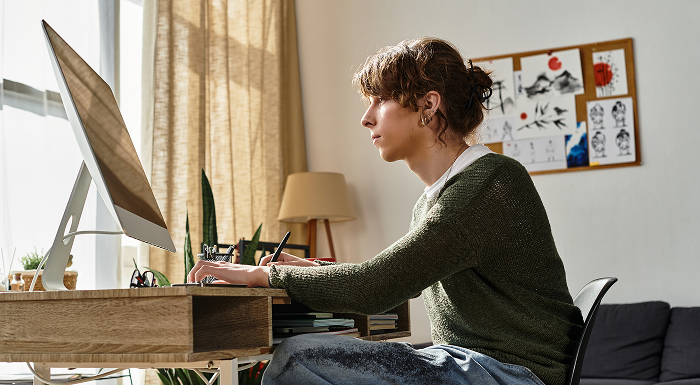Contents
- How Website Design Impacts Your Business
- Website Design Benefits For Your Business
- Key Elements Of Great Website Design
- Passing The Four Second Test
- Choosing A Website Design Agency That Delivers
- FAQs About Why Website Design Is Important
- FAQs About 1PCS Creative
- Let's Improve Your Website Design Together

Your website is like your digital storefront. Imagine walking into a shop that’s dimly lit, cluttered, and hard to navigate. You’d probably leave, right? The same goes for your website. A good website design creates a clean, welcoming experience that lets visitors quickly see what you offer.
When your website is easy to use, loads fast and looks trustworthy, people are more to continue browsing and take action such as making an enquiry or completing a purchase.
Website design isn’t just about making things look nice. It’s an essential tool that impacts your brand’s credibility, search engine rankings and ability to convert visitors into customers. In this blog post, we will explain why website design is important and break down the key elements you should focus on to help your business grow and scale.
How Website Design Impacts Your Business
Website design is about more than just choosing colours or picking pretty fonts. It’s about creating an experience.
When someone lands on your site, they’re asking themselves: “Can I trust this place?” It takes mere seconds to form that opinion. A well-designed site shows professionalism, while a poorly designed or outdated one can make people doubt your expertise.
Good design means thinking through every aspect, from the layout and structure to navigation and page speed so that visitors can find what they need without any hassle.
Also, a beautiful website isn’t just enough on its own. The design must support your content and business goals. If you run an online shop, your website design needs to highlight products and include quick methods to checkout. If your goal is lead generation, then forms, clear CTAs (call to action) and how they navigate the website are critical.
Design helps guide visitors, telling them where to look and what to do next. When designed correctly it will inform, educate and build trust to help convert potential customers on your website.
Website Design Benefits for Your Business
Builds Credibility and Trust
Have you ever judged a business based solely on how its website looks? Studies show that around 75% of people base a company’s credibility on how professional its website looks. When your design looks clean, organised and up-to-date it helps to build trust and credibility with visitors to your website.
Even small design details matter. Simple things like matching font styles, consistent colours and a smooth and simple layout give a sense of cohesion and professionalism. Which in turns helps to build trust.
Customers are more likely to make an enquiry or complete a purchase from your business. Particularly if your website design looks better than any of your main competitors who they may also have visited online.
Keeps Visitors Engaged
Google found that nearly 80% of users won’t return after having a bad experience on a website. Also, Adobe reports that 59% of people prefer beautifully designed websites over plain ones. That means if your website has a bad design or provides a negative user experience, people are going to leave to go to a competitor website very quickly.
A strong website design includes easy-to-navigate menus, clear headings and a layout that draws the eye where you want it using clear call to actions. Alongside strategic use of visuals such as images, icons and videos to help users feel more connected to your content. When the site flows naturally, is visually pleasing and simple to navigate, visitors stay longer and explore more.
Boosts Your Google Ranking
SEO and design go hand in hand. Google wants to serve users the best possible experience and design elements on your website play a big role. Your website needs to load fast, work well on mobile devices, have easy-to-read structure and use SEO-friendly elements like titles, image alt tags and headings.
A clean site structure such as logical navigation and clear content hierarchy helps search engines understand what each page is about. That can improve your visibility on Google and other search engine providers. The better your website ranks, the more organic traffic you should receive from potential customers.
Increases Conversions and Sales
A website isn’t just about having a visually pleasing design, it should help you meet your business goals too. That could be signing up for a newsletter, booking an appointment, requesting a quote or making a purchase. Good website design sets up clear pathways to conversion from visitors to your site.
For example, a well-placed “Get a Quote” button that’s visible as soon as someone scrolls. Or an image carousel showcasing products with short, persuasive text that explains the benefits. Every design choice should help guide the visitor toward taking action on your website.

Key Elements of Great Website Design
Here’s what we consider essential for any effective website design:
Simple, Intuitive Navigation
If visitors can’t find what they’re looking for within a few seconds, they’ll bounce to a competitor site. That’s why navigation needs to be clear, simple and consistent across all pages.
Including an easy-to-find menu, walking users through your main services and having clear links in the footer to help people and search engines such as Google understand your site.
Menus should include essentials such as Home, About, Services or Products, Blog/Resources, and Contact page. Drop-down menus will only work when organised clearly, if there are too many choices then it can cause confusion and visitors struggle to find what they need. Recommend keeping it clean and straightforward.
Fast Loading Speed
Would you wait more than 4 seconds for a site to load? Most users won’t. In fact, 53% in a survey said they would leave a page that takes more than 3 seconds to load. That is why site speed is central to having a good website design.
Ways you can make your website faster includes compressing images, avoiding too many plugins, using clean code and choosing good website hosting.
Tools such as Google Page Speed Insights can help you find pages with slow load times alongside recommended fixes.
Mobile-Friendly (Responsive) Design
In the UK and worldwide, more people browse on phones than desktops now. If your website breaks or isn’t user friendly on mobile, you could lose half your audience and potential customers.
Responsive design adapts your layout automatically including menus, images and the copy all reflow to fit smaller screens such as tablets and mobile phones.
A responsive website design saves you from juggling separate mobile and desktop sites which is now an outdated method of website design. Plus, Google rewards responsive sites with better rankings. Resulting in a win-win for both performance and visibility.

Engaging Visuals
A picture really is worth a thousand words when used correctly. High-quality visuals such as photos, illustrations, videos or subtle animations can make your website design stand out. Engaging visuals help to break up long blocks of text, illustrate your message and can evoke emotion and interest.
We recommend to not go overboard with the number of images. As too many large images can slow your site. It is best to use visuals that support your specific message or business.
Videos can also work well in hero sections or product pages, provided they don’t auto-play loudly or drag down the site performance. It is important to get the balance right as part of your website design.
Clear, Benefits-Driven Content
Good website content is about people and creating a personality for your business, highlighting what your unique selling points are and how you can solve their problems. For example, instead of listing features (“Our software has A, B, C”), focus on benefits that help your potential customer (“Save 2 hours a day with our automation”).
Use simple language ensuring there is no complex terminology that your target audience won’t know. Use short paragraphs, informative headings and clear calls-to-action throughout your website.
The reality is most visitors to your website will skim information to find the relevant part to their problem, so it is important to make your content scannable.
Make use of bullet points, bold text, and subheads to help guide the eye as a visitor navigates the page. Ensuring to always lead with value, telling potential customers exactly what problem you can solve for them.
Strong Calls-to-Action (CTAs)
Every page should point visitors toward what action to take next based on your business goals. This is where well-designed call to action buttons or links in relevant locations are essential to drive conversions on your website.
Examples of call to actions include “Get a Free Quote” “Book a Demo” “Add to Basket” or “Learn More.” Make them bold and easy to spot, for example use bright or contrasting colours that stand out and keep the text action focused and direct.
A good CTA isn’t just visible, it needs to be relevant to the content on the page. On a services page, for example “Talk to an Expert” or “Start a Free Trial” will have more impact and results than saying “Click Here.”
The message should match the user’s mindset and address the likely problem they are looking to resolve on your website.
Consistent Branding
Brand consistency helps to build trust and recognition. That means using the same logo style, colour palette, fonts and tone of voice across every page on your website. Even small details such as button styles or icon sets need to all match for consistent branding for your business.
Brand consistency also extends to your imagery and copy. If your brand is friendly and informal, your visuals and tone should reflect that. If use different styles it can make your website feel disjointed and not a genuine reflection of your brand and business.
If you already have a set of brand guidelines for your logo, colours and fonts then ensure to use this throughout to keep the same look and feel to your website as your other marketing materials such as adverts, leaflets, brochures and business stationery.

Social Proof
People trust the experiences of others more than your own point of view. Reviews, testimonials, awards and client logos provide valuable social proof that can greatly influence decisions. Including a single, genuine quote from a happy client as a testimonial can be more powerful than a polished description of your services.
Testimonials can be added to your homepage, services pages or even product pages to establish social proof and trust for your business. Video testimonials can also be impactful, showing real people sharing real results.
This kind of proof directly combats any doubt if a visitor isn’t familiar with your business and helps to build trust and confidence quickly. Which in turn will help to speed up the decision process and likelihood of converting to an enquiry or purchase.
Accessible Design
Great website design should ensure to be inclusive. That means making sure your website design works for people with disabilities. Some simple accessibility steps include:
- Adding alt text to images, so screen readers can describe them
- Ensuring good contrast between text and background
- Using clear language and readable fonts
- Making sure your site can be navigated with a keyboard alone
These steps not only help visitors to your site, they can also boost SEO and reflect well on your business showing that you want everyone to able to access your site.
Passing “The Four Second Test”
Here’s an easy way to check if your homepage is working: give it the Four-Second Test. Have someone open your page, start a timer and then stop after four seconds. Ask them: “What was this page about?” If they can’t answer, your design isn’t communicating clearly enough.
The aim from the test is to ensure your hero section (the first area visitors will see) shows:
- Who you are
- What you offer
- Who you help
- What action they should do next (like “Contact us” or “Learn more”)
It doesn’t have to be overcomplicated to achieve this, the focus is to be clear and direct. Other ways to help achieve the above is adding concise headings, a short benefit statement and including a bold CTA above the fold.

Choosing a Website Design Agency That Delivers
Working with the right design agency can make or break your project. Here’s how to choose wisely:
Review their portfolio
Look at their past work to see if their style matches what you vision. Check for modern, responsive designs and diverse industries including those similar to yours. This helps to demonstrate flexibility and experience.
Check testimonials & reviews
Client feedback gives insight into their reliability, communication style and results. Did they deliver on time? Do clients feel they got value? That’s key information to look for on their reviews and testimonials.
Understand their process
A great agency starts with discovery, taking the time to learn about your business, audience and business goals. They provide clear project steps, timelines and check in points.
Know your own goals
Before engaging with a website design agency, it is worthwhile clarifying your business priorities. Do you want more leads? Better branding? An online shop? Having clearly defined goals helps the agency tailor the design to meet those needs.
At 1PCS Creative, we begin every project with a strategy session. We talk about who your audience is, what they need and how your website should perform. Keeping the focus on delivering results for your business.
FAQs About Why Website Design Is Important
Why is website design so important for businesses?
Good website design builds trust, benefits SEO, engages users and guides them toward action. It shapes how people perceive your business and whether they choose you over competitors.
How does design affect SEO?
Design impacts SEO through mobile-responsiveness, page speed, site structure and semantic markup. Clean code, clear heading, and image alt-text help search engines index your site better.
How often should I redesign my website?
Every 2–3 years is a good refresher schedule. Update sooner if your audience changes, your brand evolves, or if your site starts looking dated or loading slowly.
What makes good website design?
A solid website design is clean, fast, mobile-friendly, intuitive and brand-consistent. It supports user needs and business goals throughout the website.
What is responsive design?
It’s an approach that ensures your website looks great and functions well on all devices including phones, tablets and desktops. Instead of separate versions, one site adapts dynamically based on screen size.
FAQs About 1PCS Creative
Who is 1PCS Creative?
1PCS Creative is a Leicester based agency specialising in website design, SEO, digital marketing and online growth strategies. We’ve been helping businesses to grow and scale for over 20 years.
What services do you offer?
We build custom websites, optimise for search engines, manage digital marketing campaigns, and provide ongoing support from hosting to updates and regular maintenance.
How much does a website cost from 1PCS Creative?
Costs vary depending on complexity whether you need e-commerce, custom features, content strategy, etc. We offer scalable options for startups, small businesses, and established companies. Please get in touch to find out more and for a no-obligation quote.
Do you provide ongoing maintenance?
We offer support packages that cover website hosting, updates, security checks, speed optimisation and regular site maintenance and improvements as your business grows.
Let’s Improve Your Website Design Together
Your website should be working hard with a focus on bringing in leads, building trust and helping your business stand out ahead of your competitors. If it isn’t achieving that now for your business, then it might be time to consider a website design refresh.
At 1PCS Creative, we build and design websites that don’t just look good, they perform to drive new business and opportunities to businesses. With business growth and scale in mind. We combine strategy, design and optimisation to ensure every part of your website supports your business goals.
We can review your current website to help provide guidance and recommendations on how your website design can be improved to bring in more leads and seals. Please feel free to get in touch with one of our team to discuss further how we can help.
Ben Webster
Creative director at 1PCS. Addicted to design, SEO, pizza and helping companies big and small succeed online.

